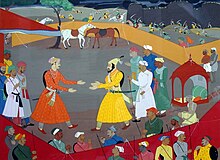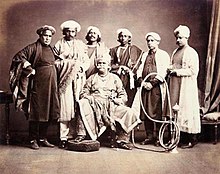Our website is made possible by displaying online advertisements to our visitors.
Please consider supporting us by disabling your ad blocker.
Raja




| Part of a series on |
| Imperial, royal, noble, gentry and chivalric ranks in West, Central, South Asia and North Africa |
|---|
 |
Raja (/ˈrɑːdʒɑː/; from Sanskrit: राजन्, IAST rājan-) is a noble or royal Sanskrit title historically used by some Indian rulers and monarchs and highest-ranking nobles. The title was historically used in the Indian subcontinent and Southeast Asia.
The title has a long history in South Asia and Southeast Asia, being attested from the Rigveda, where a rājan- is a ruler, see for example the daśarājñá yuddhá, the "Battle of Ten Kings".
- ^ Eraly, A. (2007). Emperors Of The Peacock Throne: The Saga of the Great Moghuls. Penguin Books Limited. p. 672. ISBN 978-93-5118-093-7. Retrieved 27 October 2024.
Previous Page Next Page


